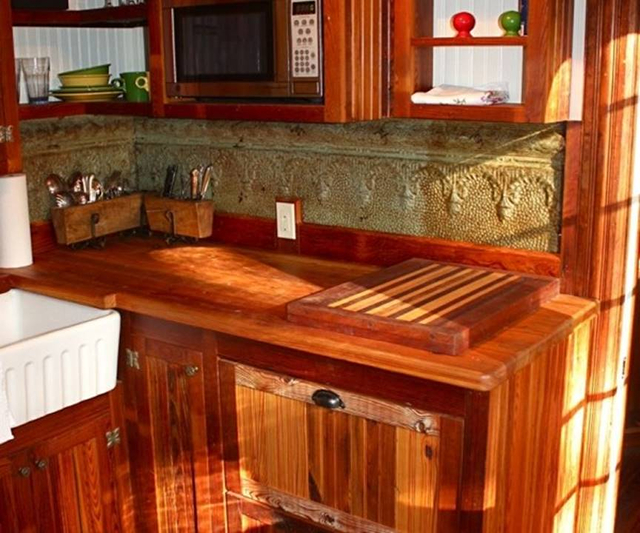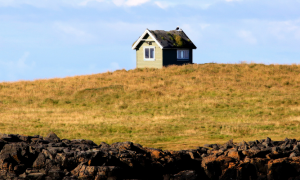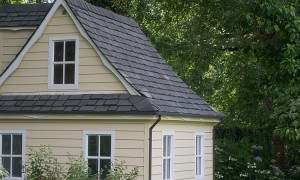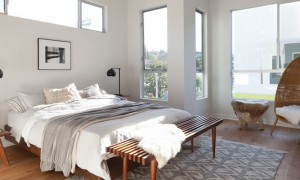By Jordan Rosenfeld
Popularized by reality television shows like Tiny House Nation, tiny homes—residences of 200 to 500 square feet—are gaining momentum. While it may seem impossible to imagine squeezing your life into such a miniscule space, tiny home aficionados have shown that it can be done comfortably and with style. Even better, tiny homes are much less expensive than traditionally sized homes, though they come with trickier financing.
If you’re intrigued by the idea of living in a tiny home, here are some key tips to consider:
Make Sure You’re Ready for a Minimalist Lifestyle
Jeremy Weaver, co-founder of Wind River Tiny Homes and a blogger at Tiny House Blog lives with his wife Lindsay, new baby and their dog in a 276-square foot tiny home he built himself on 18 acres outside Chattanooga, Tennessee. “Financial responsibility” was the first reason he chose to build a tiny home. “We wanted more control over what our work life and personal life looked like,” Weaver says. As he explains on his blog, his family loves the tiny house:
“It has saved us a ton of money and allowed us to start a business, pay off our student loans quicker and prevented us from accumulating stuff.”
In addition to small housing expenses, the couple enjoys how their small quarters encourage togetherness and communication.
While people often fear that downsizing their lives to a much smaller space will be difficult, Weaver compares it to traveling for a couple of weeks and living out of a suitcase. “Do you think about all the stuff you left at home?” he asks. “No, you’re just living with the stuff you have available to you.”
Michelle Thimesch is the founder and CEO of East Bay Revitalization, a Richmond, California nonprofit that promotes the use of accessory development units (ADUs), which are similar to tiny houses. Thimesch says tiny homes are especially good as a “starter home” for young people, people on a fixed income or those who would like to create a planned community of likeminded folks.
Be Clear About What Amenities Matter Most to You
Mindful planning and design can make or break the comfort of your tiny home. “You design [your house] for how you live,” Thimesch says. For example, one person might opt for a full bathroom instead of space for a dishwasher, while others might choose to build their tiny home on a large lot and add a porch and deck to make use of outdoor space.

Thimesch also advises to choose furnishings “that are on scale with your living environment.” Better yet, they can be customized to serve dual purposes, such as benches used for storage and seating, beds with pull-out drawers and more.
Extreme modifications to make everything fit can sometimes go too far, however. Many tiny homeowners cut corners in a way that can be dangerous, like having their sleeping quarters in a loft with no window or exit to escape through in the event of a fire. Be sure to factor in good wiring, escape routes from every level, smoke detectors, carbon monoxide alarms and other safety features.
“You’ve just got to take necessary precautions, especially when it comes to ventilation,” says Darby Lettick of Tiny Texas Houses and Pure Salvage Living in Luling, Texas.
If you don’t want to wake up groggy or with a bad headache, Lettick says your tiny home should come equipped with a variable-speed fan for proper air exchange from the outside.
Research Local House and Building Codes
The biggest challenge when it comes to a tiny home is whether your city or county permits them. Housing laws generally require a minimum square footage larger than most tiny homes, making them illegal in most jurisdictions. Some tiny home dwellers advise simply living under the radar, but this can be risky. If you run into trouble with the authorities, your tiny home could be bulldozed, according to Ryan Mitchell of TheTinyLife.com.
The good news is some cities are becoming tiny-home friendly. Fresno, California recently classified tiny homes sharing the same lot with a single-family home as legal cottages. In Washington County, Utah, officials have changed the housing code to accommodate some types of tiny homes, and Spur, Texas permits tiny homes as long as they have a permanent foundation.
The town of Salida, Colorado is working with a developer who plans to build a 200-unit tiny home community. And Washington, D.C. has recently changed its laws to accommodate tiny homes on a lot with a larger single family home–a development that tiny home advocates say may ease the housing shortage in the city.
Before you draw up plans or seek financing, check with your city and county planning departments. It would be heartbreaking to invest a lot of time and money only to be told you can’t get the proper permits for your tiny dream home.

Scope Out Your Budget and Financing
If you’re willing to put in some or all of the time and labor yourself, you can build a tiny home for less than $10,000 (on the super thrifty, DIY side) according to small home experts. However, Weaver emphasizes that the more custom details you want, the more you’ll pay. Homes made from salvage wood and parts, like The Painted Lady (above) tend to be more affordable.
If you need a mortgage to pay for your tiny house, you won’t be able to get one if the banks don’t consider your dwelling a real home. One alternative is to ensure your tiny home has wheels so you may be able to qualify for an RV loan, which is similar to a car loan. Despite this, you’ll still need to have a place that you can legally park your portable home. Your home will have to be certified as an RV by the Recreation Vehicle Industry Association to park in an RV park. Otherwise, you may not get to stay in an RV park, so having somewhere to live may mean teaming up with people who have room on their lot for a small home on wheels.
Jordan Rosenfeld is a California-based freelance writer whose work has been published in The Atlantic, The Billfold, DailyWorth, Lean Startup Co., The Washington Post and Quartz. She also covers mortgage topics for MoneyGeek.com.
Header Image Source: Shutterstock.com






